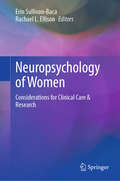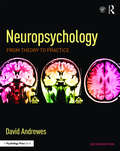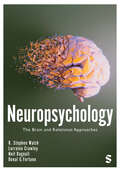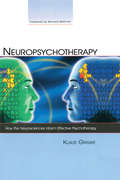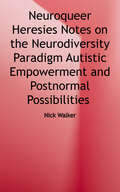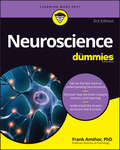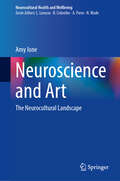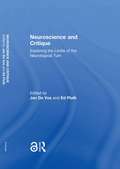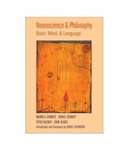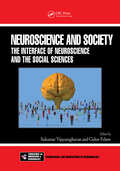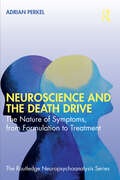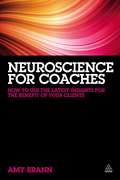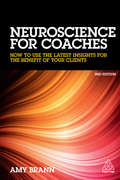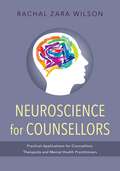- Table View
- List View
Neuropsychology of Women: Considerations for Clinical Care & Research
by Erin Sullivan-Baca Rachael L. EllisonWomen have long been underrepresented in scientific research, which has limited our understanding of how they may be uniquely impacted by various medical, psychological, and neurocognitive conditions. Due to this limitation, neuropsychological training and practice has historically fallen short of acknowledging potential sex and gender differences and effectively incorporating this knowledge into evaluations and treatment recommendations. Fortunately, in recent years, contemporary research has begun to draw more focus on unique biopsychosocial factors impacting the epidemiology, presentation, neurocognitive profile, and treatment implications for women with neuropsychological concerns. In an age of increased focus on diversity, equity, and inclusion (DEI) in the field of neuropsychology, compounded by the background of everchanging socio-political factors in the U.S. either supporting or opposing this focus, it is crucial that clinical neuropsychologists gain the knowledge and skills to provide individualized, gender-informed care to women patients. It is imperative for neuropsychology as a specialty to champion this initiative as leading experts in the intersection of cognition, mental health and disorders pertaining to the brain, which has the potential to inform clinical practice and research in related fields such as medicine and neuroscience. Neuropsychology of Women: Considerations for Clinical Care & Research provides an overview of the current research-informed knowledge base on how different conditions encountered in neuropsychological practice uniquely present in women patients. Chapters are authored by some of the foremost neuropsychological researchers and clinicians of today, spanning topics inclusive of both those impacting both genders, with a focus on the understudied and unique clinical implications related to women, as well as those disproportionately affecting women. These range from specific neurodegenerative conditions such as Alzheimer&’s disease and movement disorders, to acute events like stroke and traumatic brain injury, to chronic conditions including autoimmune disorders and epilepsy, all consolidating the literature into a concise and accessible format. Chapters focusing on chronic health conditions and issues relating to pregnancy and menopause supplement those focused on neurological conditions to help clinical providers conceptualize patients through a comprehensive neuropsychological lens and to help researchers understand where opportunities lie for further exploration. For those new to the field of neuropsychology, including students and trainees, Neuropsychology of Women: Considerations for Clinical Care & Research extends beyond traditional texts to incorporate issues of DEI through an intentional and organic approach. This is the first book of its kind in over a decade and the most comprehensive resource available to clinical neuropsychologists seeking to provide the highest standard of inclusive practice to women patients.
Neuropsychology of the Amnesic Syndrome (Psychology Library Editions: Memory)
by Alan J. Parkin Nicholas LengOriginally published in 1993, this book provides the clinician, researcher and student with a comprehensive account of the neuropsychology of the amnesic syndrome. The opening chapter places the amnesic syndrome within the overall context of memory disorders and provides a theoretical basis for understanding the presentation of the clinical and experimental findings which form the major part of the work. The second chapter provides an extensive account of the various methods used to assess memory and associated deficits and provides guidelines as to the most effective assessment strategy. The next five chapters are concerned with the specific aetiologies giving rise to the amnesic syndrome: Wernicke-Korsakoff Syndrome; Thalamic Amnesia; Medial Temporal Lobe Amnesia; Herpes Simplex Encephalitis; and ruptured aneurysms of the anterior communicating artery. Each of these chapters contains an account of the associated neuropathology, descriptions of experimental findings and illustrative case histories from the authors’ own experimental and clinical experience. The next chapter provides the reader with an account of some of the more important scientific issues that have arisen from the studies of the amnesic syndrome and a final chapter considers current and future prospects for behavioural remediation of severe memory deficit.
Neuropsychology: From Theory to Practice
by David AndrewesThe second edition of this comprehensive textbook for students of Neuropsychology gives a thorough overview of the complex relationship between brain and behaviour. With an excellent blend of clinical, experimental and theoretical coverage, it draws on the latest research findings from neuroscience, cognitive neuroscience, neurochemistry, clinical neuropsychology and neuropsychology to provide students with new insights in this fast moving field. The book is organised around the main neuropsychological disorders in the areas of perception, executive dysfunction, attention, memory, cerebral asymmetry, language, emotion and consciousness. There is a clear emphasis on bridging the gap between theory and practice with links throughout to clinical issues of both assessment and rehabilitation to build a clear understanding of the application of the theoretical issues. The final section in each chapter illustrates the importance of a more systematic approach to intervention, which takes into account theoretical views of recovery from brain damage. New to this edition: A new chapter format that includes a "basic topic" section, which contains up-to-date essential knowledge of the topic and a "further topics" section for a more advanced treatment of the area. A new section on neuroscientific approaches to rehabilitation in each chapter to make links between scientific knowledge and clinical treatment. A brand new chapter on consciousness A new full colour layout with increased pedagogical features, including key terms, section summaries, 'study questions' and improved presentation of figures and brain diagrams A companion website including related weblinks, guidance on answering the 'study questions', and flashcards. This book will be invaluable for undergraduate students in Neuropsychology and students who wish to take the subject further to the various clinical fields.
Neuropsychology: The Brain and Relational Approaches
by R. Stephen Walsh Lorraine Crawley Neil Dagnall Donal G. FortuneNeuropsychology: The Brain and Relational Approaches provides a clinically oriented introduction to neuropsychology through a relational lens. Covering historical and theoretical foundations, neuropsychological function and dysfunction, and clinical practice, this text is an essential resource for understanding and treating brain injury. Its emphasis on a relational approach to neuropsychology also helps students understand the profound impact of social and environmental factors on brain function and recovery. With fascinating real-life case studies of patients throughout, this text is ideal for students taking neuropsychology modules in psychology and related fields. R. Stephen Walsh is a Senior Lecturer in the Department of Psychology at Manchester Metropolitan University. Lorraine Crawley is a Senior Clinical Psychologist/Clinical Coordinator with the University of Limerick Clinical Psychology Doctorate Programme. Neil Dagnall is a Professor in Applied Cognitive Psychology at Manchester Metropolitan University. Donal G. Fortune is a Full Professor and the Chair of Clinical Psychology at the University of Limerick.
Neuropsychology: The Brain and Relational Approaches
by R. Stephen Walsh Lorraine Crawley Neil Dagnall Donal G. FortuneNeuropsychology: The Brain and Relational Approaches provides a clinically oriented introduction to neuropsychology through a relational lens. Covering historical and theoretical foundations, neuropsychological function and dysfunction, and clinical practice, this text is an essential resource for understanding and treating brain injury. Its emphasis on a relational approach to neuropsychology also helps students understand the profound impact of social and environmental factors on brain function and recovery. With fascinating real-life case studies of patients throughout, this text is ideal for students taking neuropsychology modules in psychology and related fields. R. Stephen Walsh is a Senior Lecturer in the Department of Psychology at Manchester Metropolitan University. Lorraine Crawley is a Senior Clinical Psychologist/Clinical Coordinator with the University of Limerick Clinical Psychology Doctorate Programme. Neil Dagnall is a Professor in Applied Cognitive Psychology at Manchester Metropolitan University. Donal G. Fortune is a Full Professor and the Chair of Clinical Psychology at the University of Limerick.
Neuropsychosocial Intervention: The Practical Treatment of Severe Behavioral Dyscontrol After Acquired Brain Injury
by Robert L. KarolNeuropsychosocial intervention is an innovative and clinically proven treatment approach to severe behavioral problems that can affect persons with acquired brain injury. This book outlines the nature and significance of behavioral dyscontrol, explains aggression, and details the neuropsychosocial treatment approach and the principles on which it i
Neuropsychotherapy: How the Neurosciences Inform Effective Psychotherapy (Counseling and Psychotherapy)
by Klaus GraweNeuropsychotherapy is intended to inspire further development and continual empirical updating of consistency theory. It is essential for psychotherapists, psychotherapy researchers, clinical psychologists, psychiatrists, neuroscientists, and mental-health professionals. Profoundly important and innovative, this volume provides necessary know-how for professionals as it connects the findings of modern neuroscience to the insights of psychotherapy. Throughout the book, a new picture unfolds of the empirical grounds of effective psychotherapeutic work. Author Klaus Grawe articulates a comprehensive model of psychological functioning-consistency theory-and bridges the gap between the neurosciences and the understanding of psychological disorders and their treatment. Neuropsychotherapy illustrates that psychotherapy can be even more effective when it is grounded in a neuroscientific approach. Cutting across disciplines that are characteristically disparate, the book identifies the neural foundations of various disorders, suggests specific psychotherapeutic conclusions, and makes neuroscientific knowledge more accessible to psychotherapists. The book's discussion of consistency theory reveals the model is firmly connected to other psychological theoretical approaches, from control theory to cognitive-behavioral models to basic need theories.
Neuroqueer Heresies: Notes on the Neurodiversity Paradigm, Autistic Empowerment, and Postnormal Possibilities
by Nick WalkerThe work of queer autistic scholar Nick Walker has played a key role in the evolving discourse on human neurodiversity. Neuroqueer Heresies collects a decade's worth of Dr. Walker's most influential writings, along with new commentary by the author and new material on her radical conceptualization of Neuroqueer Theory. This book is essential reading for anyone seeking to understand the foundations, terminology, implications, and leading edges of the emerging neurodiversity paradigm.
Neuroscience For Dummies
by Frank AmthorA fascinating look at what’s rattling around in your skull Neuroscience For Dummies introduces you to the mind-boggling study of the human brain. It tracks to the content of a typical introductory neuroscience class at the college level —and it’s perfect for anyone curious about what makes us tick. New technologies and an explosion of research have completely transformed our understanding of memory, depression, the mind-body connection, learning, and genetics. This updated edition—still in classic, beginner-friendly Dummies style—covers the latest research advances and technologies in the field of neuroscience. Put some knowledge about the brain into your brain. Grasp the basic concepts and applications of neuroscience Understand the brain’s structure and function Explore how the brain impacts memory, learning, and emotions Discover how the brain is connected with other physical systemsFor students and general readers alike, Neuroscience For Dummies is a great way to understand what’s going on inside our heads.
Neuroscience and Art: The Neurocultural Landscape (Neurocultural Health and Wellbeing)
by Amy IoneThis book is focused on how understanding ourselves as humans is incomplete without considering both biological and cultural aspects. Using the neurocultural perspective, the book explores how everything in the world is filtered back and forth through the brain and culture. The thrust of the book, therefore, is to explore the power of art in creating a bridge between cultural and neuroscientific lines of inquiry. Looking at both clinical and non-clinical populations, the text examines historical foundations, distinguishes congenital/developmental conditions from those that are acquired, and emphasizes how the brain constructs our sensory experiences. Several distinctive features separate this research from other publications. First, the book opens with a review of how the historical literature is still etched into the ideas we employ to explain elements across the interdisciplinary fields of art, aesthetics, our sensory experience, psychology, cognition, and well-being. Second, the research adopts a humanistic rather than a philosophical or social science perspective in demonstrating the value of coupling anatomy and physiology with the natural and social environment. In this, artists from all genres are incorporated. Among them are Iris Murdoch, Ludwig van Beethoven, Leonardo da Vinci, Cristoforo de Predis, Rembrandt, Federico Fellini, Chuck Close, and David Hockney. Case studies demonstrate how neuroscientific research meshes with art, individual, and cultural variables in ways that range from health and well-being to physiological decline and biological traumas. These include a case study that examines how Oliver Sacks combined biology and biography in his writings. It also explores art projects in several genres inspired by his studies. Another case study is on the role of film as a useful clinical tool. Here the book also demonstrates that cinematic devices used by filmmakers intersect with perceptual and cognitive neuroscience. A defining feature of the analysis is the integration of research on brain injuries with humanistic responses in film, literature, and the visual arts. This section outlines the lack of consensus regarding the causes and treatment of “shell shock” in World War I before introducing how research and art now work with PTSD/TBI. Finally, the book examines therapeutic cases of professional and non-professional artists, concluding with a discussion of synesthesia and the senses.
Neuroscience and Connectionist Theory (Developments in Connectionist Theory Series)
by Mark A. Gluck David E. RumelhartWritten for cognitive scientists, psychologists, computer scientists, engineers, and neuroscientists, this book provides an accessible overview of how computational network models are being used to model neurobiological phenomena. Each chapter presents a representative example of how biological data and network models interact with the authors' research. The biological phenomena cover network- or circuit-level phenomena in humans and other higher-order vertebrates.
Neuroscience and Critique: Exploring the Limits of the Neurological Turn
by Ed Pluth Jan De VosRecent years have seen a rapid growth in neuroscientific research, and an expansion beyond basic research to incorporate elements of the arts, humanities and social sciences. It has been suggested that the neurosciences will bring about major transformations in the understanding of ourselves, our culture and our society. In academia one finds debates within psychology, philosophy and literature about the implications of developments within the neurosciences, and the emerging fields of educational neuroscience, neuro-economics, and neuro-aesthetics also bear witness to a 'neurological turn' which is currently taking place. Neuroscience and Critique is a ground-breaking edited collection which reflects on the impact of neuroscience in contemporary social science and the humanities. It is the first book to consider possibilities for a critique of the theories, practices, and implications of contemporary neuroscience. Bringing together leading scholars from several disciplines, the contributors draw upon a range of perspectives, including cognitive neuroscience, critical philosophy, psychoanalysis, and feminism, and also critically examine several key ideas in contemporary neuroscience, including: The idea of "neural personhood" Theories of emotion in affective neuroscience Empathy, intersubjectivity and the notion of "embodied simulation" The concept of an "emo-rational" actor within neuro-economics. The volume will stimulate further debate in the emerging field of interdisciplinary studies in neuroscience, and will appeal to researchers and advanced students in a range of disciplines including critical psychology, philosophy, and critical studies.
Neuroscience and Education: A Philosophical Appraisal (Routledge International Studies in the Philosophy of Education)
by Clarence W. JoldersmaThis volume makes a philosophical contribution to the application of neuroscience in education. It frames neuroscience research in novel ways around educational conceptualizing and practices, while also taking a critical look at conceptual problems in neuroeducation and at the economic reasons driving the mind-brain education movement. It offers alternative approaches for situating neuroscience in educational research and practice, including non-reductionist models drawing from Dewey and phenomenological philosophers such as Martin Heidegger and Merleau-Ponty. The volume gathers together an international bevy of leading philosophers of education who are in a unique position to contribute conceptually rich and theoretically framed insight on these new developments. The essays form an emerging dialogue to be used within philosophy of education as well as neuroeducation, educational psychology, teacher education and curriculum studies.
Neuroscience and Philosophy
by Felipe De Brigard and Walter Sinnott-ArmstrongPhilosophers and neuroscientists address central issues in both fields, including morality, action, mental illness, consciousness, perception, and memory. Philosophers and neuroscientists grapple with the same profound questions involving consciousness, perception, behavior, and moral judgment, but only recently have the two disciplines begun to work together. This volume offers fourteen original chapters that address these issues, each written by a team that includes at least one philosopher and one neuroscientist who integrate disciplinary perspectives and reflect the latest research in both fields. Topics include morality, empathy, agency, the self, mental illness, neuroprediction, optogenetics, pain, vision, consciousness, memory, concepts, mind wandering, and the neural basis of psychological categories. The chapters first address basic issues about our social and moral lives: how we decide to act and ought to act toward each other, how we understand each other&’s mental states and selves, and how we deal with pressing social problems regarding crime and mental or brain health. The following chapters consider basic issues about our mental lives: how we classify and recall what we experience, how we see and feel objects in the world, how we ponder plans and alternatives, and how our brains make us conscious and create specific mental states.
Neuroscience and Philosophy: Brain, Mind, and Language
by Peter Hacker Daniel Dennett John Searle Maxwell BennettIn Neuroscience and Philosophy, three prominent philosophers and a leading neuroscientist clash over the conceptual presuppositions of cognitive neuroscience. The book begins with an excerpt from Maxwell Bennett and Peter Hacker's Philosophical Foundations of Neuroscience (Blackwell, 2003), which questions the conceptual commitments of cognitive neuroscientists. Their position is then criticized by Daniel Dennett and John Searle, two philosophers who have written extensively on the subject, and Bennett and Hacker in turn respond. Their impassioned debate encompasses a wide range of central themes: the nature of consciousness, the bearer and location of psychological attributes, the intelligibility of so-called brain maps and representations, the notion of qualia, the coherence of the notion of an intentional stance, and the relationships between mind, brain, and body. Clearly argued and thoroughly engaging, the authors present fundamentally different conceptions of philosophical method, cognitive-neuroscientific explanation, and human nature, and their exchange will appeal to anyone interested in the relation of mind to brain, of psychology to neuroscience, of causal to rational explanation, and of consciousness to self-consciousness.In his conclusion Daniel Robinson (member of the philosophy faculty at Oxford University and Distinguished Professor Emeritus at Georgetown University) explains why this confrontation is so crucial to the understanding of neuroscientific research. The project of cognitive neuroscience, he asserts, depends on the incorporation of human nature into the framework of science itself. In Robinson's estimation, Dennett and Searle fail to support this undertaking; Bennett and Hacker suggest that the project itself might be based on a conceptual mistake. Exciting and challenging, Neuroscience and Philosophy is an exceptional introduction to the philosophical problems raised by cognitive neuroscience.
Neuroscience and Psychology of Meditation in Everyday Life: Searching for the Essence of Mind
by Dusana DorjeeNeuroscience and Psychology of Meditation in Everyday Life addresses essential and timely questions about the research and practice of meditation as a path to realization of human potential for health and well-being. Balancing practical content and scientific theory, the book discusses long-term effects of six meditation practices: mindfulness, compassion, visualization-based meditation techniques, dream yoga, insight-based meditation and abiding in the existential ground of experience. Each chapter provides advice on how to embed these techniques into everyday activities, together with considerations about underlying changes in the mind and brain based on latest research evidence. This book is essential reading for professionals applying meditation-based techniques in their work and researchers in the emerging field of contemplative science. The book will also be of value to practitioners of meditation seeking to further their practice and understand associated changes in the mind and brain.
Neuroscience and Social Science
by Agustín Ibáñez Lucas Sedeño Adolfo M. GarcíaThis book seeks to build bridges between neuroscience and social science empirical researchers and theorists working around the world, integrating perspectives from both fields, separating real from spurious divides between them and delineating new challenges for future investigation. Since its inception in the early 2000s, multilevel social neuroscience has dramatically reshaped our understanding of the affective and cultural dimensions of neurocognition. Thanks to its explanatory pluralism, this field has moved beyond long standing dichotomies and reductionisms, offering a neurobiological perspective on topics classically monopolized by non-scientific traditions, such as consciousness, subjectivity, and intersubjectivity. Moreover, it has forged new paths for dialogue with disciplines which directly address societal dynamics, such as economics, law, education, public policy making and sociology. At the same time, beyond internal changes in the field of neuroscience, new problems emerge in the dialogue with other disciplines.Neuroscience and Social Science – The Missing Link puts together contributions by experts interested in the convergences, divergences, and controversies across these fields. The volume presents empirical studies on the interplay between relevant levels of inquiry (neural, psychological, social), chapters rooted in specific scholarly traditions (neuroscience, sociology, philosophy of science, public policy making), as well as proposals of new theoretical foundations to enhance the rapprochement in question.By putting neuroscientists and social scientists face to face, the book promotes new reflections on this much needed marriage while opening opportunities for social neuroscience to plunge from the laboratory into the core of social life. This transdisciplinary approach makes Neuroscience and Social Science – The Missing Link an important resource for students, teachers, and researchers interested in the social dimension of human mind working in different fields, such as social neuroscience, social sciences, cognitive science, psychology, behavioral science, linguistics, and philosophy.
Neuroscience and Society: The Interface of Neuroscience and the Social Sciences (Frontiers in Neuroscience)
by Sukumar Vijayaraghavan Gidon FelsenAdvances in neuroscience research are rapidly redefining what it means to be human. The absence of the brain/mind dichotomy has, in turn, removed the separation between our brain biology and our sociocultural experiences, raising questions for social sciences to address. How responsible are we, as individuals, for our actions? Do we have free will? Is it ethical for us to peer into others’ brains? How are our collective social cultural norms influenced by our brain function? At the same time, neuroscientists need to develop better intuition about the ethical, legal, and social implications of their research. Close collaboration between neuroscience and social sciences is the best way forward.This book acts as an introduction to these and other issues that lie at the interface of neuroscience and social sciences, using the physiological underpinnings of our decision-making processes as a framework. Examples of topics addressed here are: Neuroscience and economics Neuroscience and law Neuroscience and ethics Neuroscience and mental health Neuroscience of religion and humour The book is intended for students of neuroscience and social sciences, as well as readers generally interested in the human condition. It is hoped that the book will stimulate cross-disciplinary thinking and inspire a new generation of thinkers who are willing to look at both social sciences and neuroscience research with a different lens. Such bridge builders will be the pioneers of the next level of interrogation at this emerging interface.
Neuroscience and the Death Drive: The Nature of Symptoms, from Formulation to Treatment (The Routledge Neuropsychoanalysis Series)
by Adrian PerkelIn this book, Adrian Perkel seeks to expand upon Freud’s theory of the death drive by locating it within modern neuroscience, arguing for the centrality of the aggressive drive in the formation of mind, and the genesis of symptoms and psychopathology. Neuroscience and the Death Drive reformulates the function of defence mechanisms as they link to the aggressive drive and their role in the binding of free energy. Filling an important gap in both formulation and treatment, this book completes Freud’s self-confessed incomplete theory of aggression through the lens of modern psychoanalysis and neuroscience, updating these concepts with current scientific insights, and introduces a refreshed view on psychotherapeutic treatment implications based on these developments. Perkel explores the treatment of patients experiencing eating disorders, anxiety, depression, addiction, personality disorders and sexual dysfunction. This invigorating and approachable book will be of interest to all psychoanalysts, psychiatrists, psychotherapists and counsellors, and will help readers reach new understandings of this key theory of the mind.
Neuroscience for Change at Work: Practical Insights to Overcome Workforce Resistance to Organizational Change
by Melanie Franklin Tibisay VeraHow do I communicate change to the business? How do I maintain productivity and wellbeing during change? How do I deal with resistance to business change?Neuroscience for Change at Work answers these questions and explains how to use insights from neuroscience when designing change and communicating it to employees. It is based on the PEPE model which outlines the four fundamental principles that drive resistance to change in individuals, teams and the wider organization. This book provides specific coverage of how neuroscience can inform change initiatives in remote, hybrid and in-person working environments to ensure successful business transformation in any working model. There is also discussion of how change can impact employee mental health and wellbeing and explains how using insights from neuroscience can help to safeguard this. There is also discussion of how to handle competing priorities from different groups of employees during times of business change. Every chapter of Neuroscience for Change at Work is supported by practical examples, tips, tools and case studies as well as robust, evidence-based insights from neuroscience. Co-authored by a neuroscientist with extensive experience in applying neuroscience to business transformation projects, this book is a practical guide for all change managers and anyone responsible for employee engagement, wellbeing and productivity during times of change.
Neuroscience for Clinicians
by C. Alexander Simpkins Annellen M. SimpkinsThis book fills the need for an introductory text that opens the field up to the beginner and takes them to higher-level thinking about neuroscience. Neuroscience has captured the interest of students, professionals, and the general public. In fact it is so new, that there are very few books that gather it together in one text. Neuroscience is an amalgamation of many fields: psychology, cognitive science, chemistry, biology, engineering, philosophy, mathematics, and statistics. People who are new to the discipline have to be able to find their way through all of these fields together. In addition, they need to understand the highly technical lexicon, modeling methods, and theoretical assumptions used to describe brain structure, function, and the interaction between them. This book helps readers navigate the conventions used to describe the brain that developed through the years. The authors crystallize the complex modeling methods and technologies so that readers understand what they are saying and how to use them. They address the important underlying principles and important issues of neuroscience, with the debates and discussions that are ongoing as the field evolves. They also include many salient fine-grained details so that the book is not just an overview, but also a useful guide for many levels of readers.
Neuroscience for Coaches
by Amy BrannThe world of coaching is competitive. Organisations want coaches who deliver results, and can prove it. Many coaching tools and techniques are now fairly well established - but how do they actually work? The coach who can answer this question credibly and convincingly is sought after. This ground-breaking book equips coaches with cutting edge neuroscience information that will help them deliver greater value to their clients. It covers the foundations that coaches need to be aware of and crucially, the ways they can use this new information effectively and practically in their everyday work. Readers will strengthen their kitbag of coaching tools and will be able to explain to their clients the neurological underpinning of the techniques they are using. No forward-thinking coach can afford to be ignorant of recent scientific developments: Neuroscience for Coaches will give them the practical knowledge they need.
Neuroscience for Coaches: How coaches and managers can use the latest insights to benefit clients and teams
by Amy BrannMany coaching tools and techniques are now well established, but how do they actually work? The third edition of Neuroscience for Coaches answers this question to help coaches and managers deliver greater value to clients and employees.Based on extensive research, Neuroscience for Coaches provides a clear explanation of the aspects of neuroscience that are relevant to coaching so coaches can describe to clients why particular techniques work and the benefits to be gained from using them. It also features interviews with Marshall Goldsmith, Susan Grandfield, Christian van Nieuwerburgh and Kim Morgan on topics including mindfulness and behaviour change in coaching.This fully updated third edition covers the latest neuroscientific research on key brain areas and their functions, such as the Prefrontal cortex and Amygdala which affect attention, processing and emotional regulation. With tips and insights throughout, it crucially demonstrates the ways in which coaches and managers who coach can use this information effectively and practically in their everyday work. Neuroscience for Coaches is a vital resource for improving coaching practice with the latest scientific developments, tools and techniques.
Neuroscience for Coaches: How to Use the Latest Insights for the Benefit of Your Clients
by Amy BrannMany coaching tools and techniques are now fairly well established, but how do they actually work? Neuroscience for Coaches equips coaches with information that will help them answer this question and therefore deliver greater value to clients. Based on over twelve years of research, this book provides a clear explanation of the aspects of neuroscience that are relevant to coaching so you can describe to clients from a neuroscientific perspective why particular techniques and methods work and the benefits to them.This fully updated 2nd edition of Neuroscience for Coaches includes new interviews with Marshall Goldsmith, Susan Greenfield, Christian van Nieuwerburgh and Kim Morgan, along with new material on oxytocin, goals and mindfulness. It covers the latest neuroscientific research and, crucially, the ways in which coaches can use this information effectively and practically in their everyday work. Neuroscience for Coaches is a vital resource for keeping up to date with recent scientific developments, tools and techniques in coaching.
Neuroscience for Counsellors: Practical Applications for Counsellors, Therapists and Mental Health Practitioners
by Rachal Zara WilsonThis is an invaluable resource for counsellors and therapists looking to reinvigorate their practice and enhance their understanding of clients' needs. Each chapter focuses on different discoveries in neuroscience, explains them in plain English and provides guidance on how to put this knowledge to practical use in the therapy room. It covers specific psychological and neurological diagnoses including bipolar affective disorder, eating disorders and ADHD, as well as other more general issues such as attachment and addiction. The book also contains recommendations backed by evidence from neuroscience for optimum mental health involving nutrition, sleep and exercise, and a comprehensive glossary of technical terms. Presenting the practical applications of neuroscience, this book will be of immeasurable use to counsellors, psychotherapists and psychologists, and also of interest to social workers and mental health practitioners.
